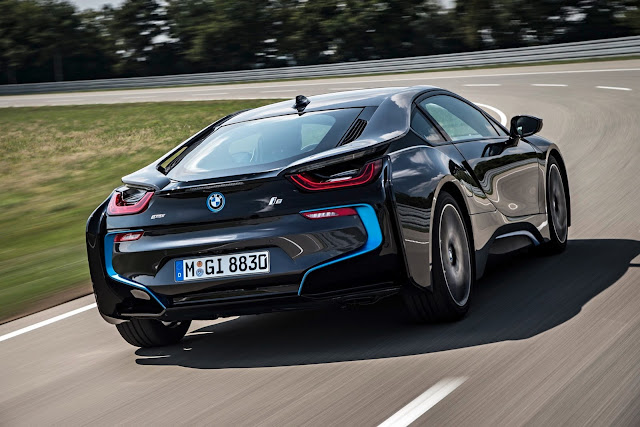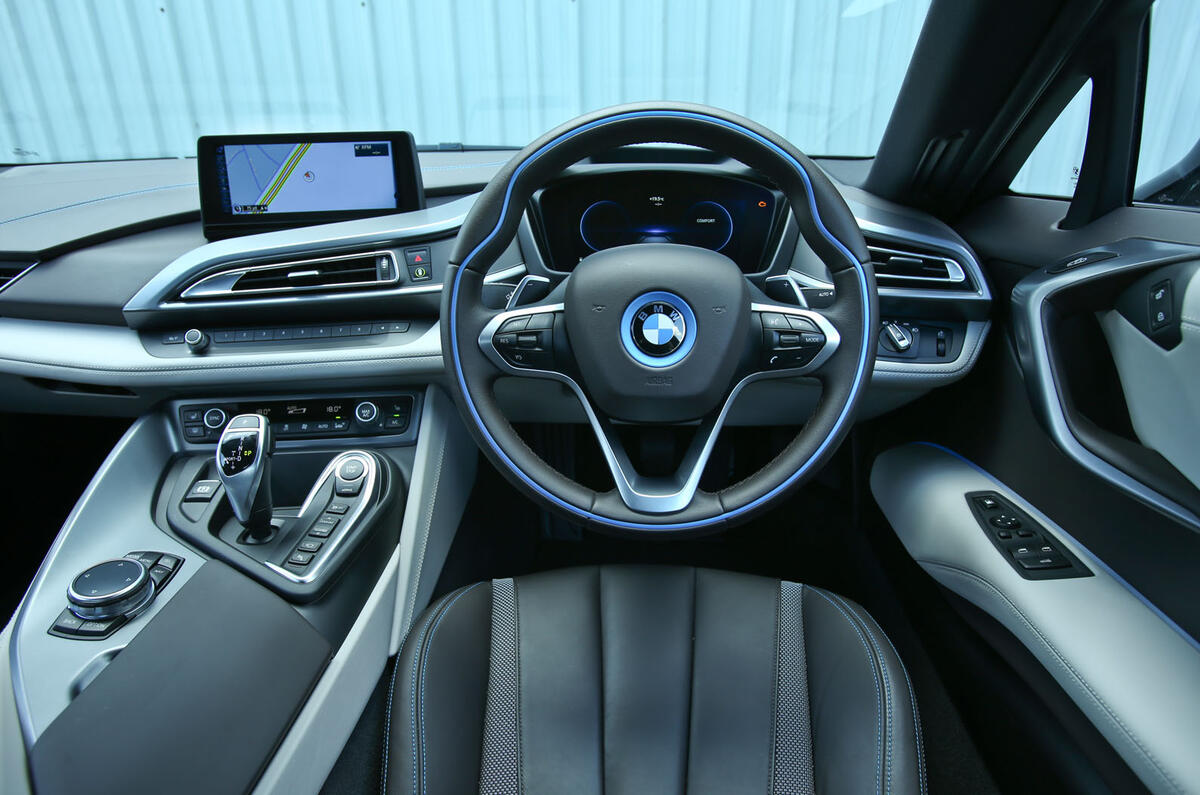The BMW i8 is a new two-door sports car of a decidedly
different stripe—for any automaker, not just the brand that brought you the
"Ultimate Driving Machine."
BMW's i8 takes a more integrated and subtle approach to a
high-performance supercar for the energy-conscious age. Instead of electric
motors paired with a heavy gasoline powertrain, the i8 uses the 1.5-liter
3-cylinder engine from the Mini lineup and electric motors for a total combined
output of 357 horsepower.
The i8's lightweight, carbon-fiber-plastic body lets the
all-wheel-drive car take full advantage of the setup for either energy savings
or supercar-like performance. It has remained largely unchanged after a short
2014 model year. In 2017, a striking Protonic Red edition with various trim accents
is newly available. The year before, BMW got permission to offer its laser
headlights, which are breathtakingly effective.
The i8 is the second vehicle to come out of the automaker's
"i" sub-brand, following the i3 city car to market. The i8 can be
considered the current technology flagship for BMW and with a base price of
more than $140,000 is easily the most expensive offering from the Bavarian
automaker to start.
Though the two are related in some ways, the i8 coupe
appeals to a different audience than the i3—those who want fast performance in
a light car without the bulk and fuel consumption of a V-8 or V-10 engine. It's
less practical than the i3 of course, and uses the weight savings and other
technologies for a combination of performance and efficiency.
First unveiled as the Vision Efficient Dynamics concept car
at the 2009 Frankfurt Motor Show, the i8 sports coupe is fitted with two
entirely separate powertrains. Up front, an electric motor draws energy from a
battery pack to drive the front wheels; a turbocharged 1.5-liter 3-cylinder
engine powers the rear wheels.

Two years later, the car had evolved into the BMW i8
Concept, which appeared at the 2011 Frankfurt Motor Show. The company has also
shown an i8 Concept Spyder, indicating that the i8 may be offered both as a
fixed-roof coupe and an open-air convertible—although the droptop version may
be a few years out.
For the 2011 car, which was much closer to the production
version, the original concept's diesel engine had been replaced by a gasoline
engine. That is BMW's new 1.5-liter 3-cylinder engine—which is used in the new
generation of Mini Coopers and pegged for a new front-wheel-drive BMW model.
For maximum acceleration and output, both power trains can
operate in concert, making the i8 an all-wheel-drive coupe that some have
called a "super car." In this mode, the i8 becomes what engineers call
a "through-the-road" hybrid, meaning that each power train operates a
different set of wheels. Though the power trains don't share an axle, the
electric motor is tuned to make up the power lost during the gasoline engine's
gear changes, ensuring a smooth and continuous flow of power.

The i8 uses a 7.1-kwh lithium-ion battery pack that runs
between the two seats; its low placement keeps the center of gravity close to
the ground for better handling. The i8 can travel at moderate speeds for as
many as 20 miles on its electric charge, with a 129-hp motor driving the front
wheels. Once the pace picks up, and in certain modes, the 3-cylinder engine
sends 228 hp and 236 pound-feet of torque to the rear wheels. When the two
power sources combine, total output reaches 357 hp, and the i8 is able to
accelerate to 60 mph in a claimed 4.4 seconds. Its top speed is limited to 155
mph.
The i8 is a very different take on a two-door sports car,
and its looks are easily as groundbreaking as the power concept. The i8 borrows
many cues from a recent concept that was itself homage to the M1 supercar.
There is also design language and some specific elements shared with the i3 EV
that's launching alongside it, but the two are strikingly different. Where the
i3 five-door is tall and large inside, with a stubby footprint, the i8 is low,
sleek, and sexy, with beautiful flowing details along its flanks that culminate
in a cantilevered wave over the rear haunches. The i3, on the other hand, is
meant to move people and stuff in comfort throughout urban areas, packing an under
floor battery that will allow 80-100 miles of EV driving per charge.
Both cars are built in two parts: an aluminum platform holds
the battery, electric motor, and other powertrain components, while a body
shell made of carbon-fiber-reinforced plastic sits on top. The combination is
light, durable, and cutting-edge, with BMW about to become the world's leading
automaker in the use of carbon fiber in mass production. The total weight of
the BMW i8 is 3,455 pounds.

To go along with the nonstandard powertrain, BMW offers the
i8 in different "Worlds" instead of what would normally be referred
to as trim levels. Basically design-and-options packages, the world’s act like
curated paths for the buyer to follow. At the top, the Pure Impulse world
includes all of the otherwise optional features, with a final MSRP just north
of $150,000.
After a brief 2014 model year, the i8 returned for 2015 with
one small change: Comfort Access has now been made standard on all models. For 2016,
laser headlights were made available on American-market cars.

No comments:
Post a Comment